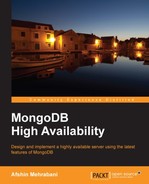Book Description
Design and implement a highly available server using the latest features of MongoDB
In Detail
MongoDB is one of the pioneers in implementing the NoSQL concept by using "Document" as the infrastructure to save and restore data from a database. Using MongoDB in high pressure situations needs a predefined plan, and this book with its step-by-step approach can help you to make a highly available MongoDB server using the latest features.
Starting with the basic concepts and their implementation, you will study real-world use cases which will help you understand the practical aspects of MongoDB. Each step contains an in-depth presentation and several screenshots. This book teaches you all the tips and tricks to make a highly available MongoDB server using different clustering solutions. This book has a perfect balance of concepts and their practical implementation along with solutions to make a highly available MongoDB server in a production environment and under high throughput with clear instructions and guidance.
What You Will Learn
- Understand MongoDB's server structure and processes
- Get to grips with using MongoDB solutions to cluster your server
- Utilize sharding and set up a sharding server architecture
- Improve server response time using different solutions
- Diagnose, monitor, and troubleshoot a MongoDB server
- Discover the replica set and how it works
- Grasp how to select a suitable sharding key
Downloading the example code for this book. You can download the example code files for all Packt books you have purchased from your account at http://www.PacktPub.com. If you purchased this book elsewhere, you can visit http://www.PacktPub.com/support and register to have the files e-mailed directly to you.
Table of Contents
- MongoDB High Availability
- Table of Contents
- MongoDB High Availability
- Credits
- About the Author
- About the Reviewers
- www.PacktPub.com
- Preface
- 1. Understanding the MongoDB Architecture and Processes
- 2. Understanding MongoDB's Failures and Limitations
- 3. Clustering in MongoDB
- 4. Utilizing a Replica Set
- 5. Replica Set in Action
- 6. Understanding the Concept of Sharding
- 7. Sharding in Action
- 8. Analyzing and Improving Database Performance
- 9. Migrating Instances and Reducing Downtime
- 10. Monitoring and Troubleshooting the Database
- Index
